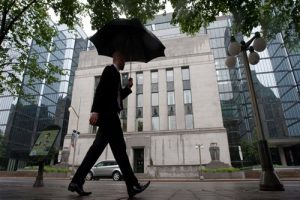Bank of Canada makes interest rate announcement
by Bloomberg 17 Jan 2018

The Bank of Canada pushed forward with another quarter-point interest rate increase and said more hikes are likely coming, even as it cautioned it isn’t in any rush to return rates to more normal levels.
Policy makers led by Governor Stephen Poloz increased the benchmark overnight rate to 1.25 percent, the highest since the global recession and their third hike since July. The move is a nod to a red-hot economy running up against capacity with a jobless rate at the lowest in more than four decades.
At the same time, central bank officials repeated their dovish language about moving ahead cautiously and warned they expect the economy will require continued stimulus to remain at capacity.
“While the economic outlook is expected to warrant higher interest rates over time, some continued monetary policy accommodation will likely be needed to keep the economy operating close to potential and inflation on target,” the Bank of Canada said Wednesday in a statement from Ottawa. “Governing Council will remain cautious in considering future policy adjustments.”
Key Takeaways
In raising rates, the Bank of Canada points to strong data, inflation at target and economy at capacity — and says more hikes are expected.
At the same time, it retains cautious language about future adjustments and adds new language around the need for continued monetary accommodation
The central bank cites growing risks around North American Free Trade Agreement negotiations, which are “weighing increasingly” on Canada’s economic outlook
Canada becomes the first major central bank to move ahead with a rate increase in 2018. Investors have spent the early days of the year watching central banks around the world for signs the period of extraordinary stimulus is coming to an end. The Bank of Japan jolted bond markets with a surprise change to its purchasing program, while some European Central Bank officials have called for their bond-buying program to end in September.
Striking Balance
For months, Poloz has been trying to strike a balance between gradually bringing interest rates back to more normal levels amid faster-than-expected growth and an employment boom, without triggering a slowdown.
A recent run of strong economic data has made that task more difficult, and the improved outlook was evident throughout Wednesday’s rate statement and monetary policy report.
The central bank painted a picture of an economy with inflation already close to target, output largely at capacity, a stronger- than-expected housing sector, and a faster-than-expected reduction in labor market slack.
That prompted officials to increase their projections for inflation in 2018, and growth over the next two years.
The reasons to remain cautious are less tangible, centered around growing concerns about the outcome of Nafta negotiations.
“Uncertainty surrounding the future of the North American Free Trade Agreement is clouding the economic outlook,” the central bank said.
Rate Sensitivity
There are also questions about the economy’s sensitivity to interest rate increases and whether its potential growth could be accelerating. The bank said wage gains remain modest, even with a recent pickup.
The Bank of Canada forecast a bigger hit on exports and business investment due to worries about Nafta, and incorporated an increased sensitivity of interest rates because of the country’s high household debt levels.
The rate increase was expected by 26 of 27 economists surveyed by Bloomberg News and investors had almost fully priced in a hike.
Questions remain about how quickly the central bank will raise from here and where rates will eventually settle. Markets had been pricing in at least three increases this year, which would bring the benchmark rate to 1.75 percent.
The Bank of Canada retained its estimate that its so-called neutral rate — a sort of Goldilocks rate that keeps the economy neither too hot nor too cold — is at about 3 percent. But the comments on the need for continued accommodation at full capacity could suggest policy makers aren’t anticipating a return to neutral any time soon.
The central bank also increased its forecast for how quickly the economy could grow without triggering inflation — to an average of 1.6 percent over the projection horizon. The central bank said it is monitoring the extent to which strong demand could boost potential growth further.
“In this respect, capital investment, firm creation, labor force participation, and hours worked are all showing promising signs,” it said, adding that wages have picked up by less than what “would be typical” for a labor market without slack.
Call us before the next rate hike 905 357 5366
Copyright Bloomberg News